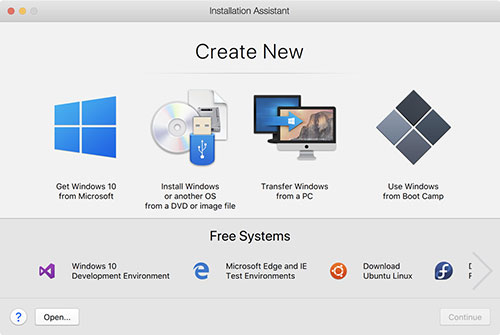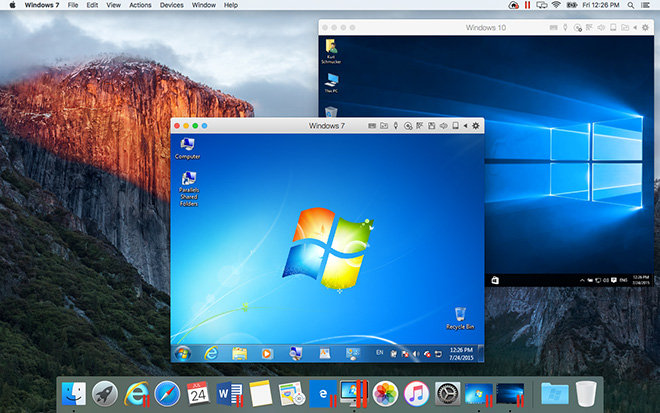- Parallels Desktop Review
- Visual Studio For Mac Review
- Parallels Desktop For Mac With Microsoft Windows Installed
- Parallels Desktop For Mac Free
- Parallels Desktop For Mac Free
- Parallels Desktop For Mac Visual Studio 2013
Parallels Desktop for Mac is a hypervisor-based virtualization solution that makes it easy to run any number of operating systems inside separate windows on your Mac desktop. For developers, this means you can simultaneously run Xcode on Mac and Visual Studio on Windows 8. The Parallels window behaves like a normal Mac window, so you can copy content from your desktop and place it directly into the Parallels virtual machine instance just as you would from one Mac window to another. You can even run Visual Studio (and other Windows applications) directly on the Mac OS X desktop (no Windows VM window, just the app).
- Here, Kurt Schmucker, a senior product manager at Parallels, provides a quick demo of virtualized operating systems in Parallels Desktop for Mac Pro Edition, how to test with network conditions of.
- Parallels Desktop 11 for Mac Pro Edition is the easiest and most powerful solution for developers, power users, and other demanding pros looking to increase productivity.
For cross-platform development of iOS apps, Windows Store Apps, and Windows Phone 8 apps, Parallels is unparalleled since you can work with two different operating systems and related dev tools at the same time, in the same session, from the same desktop.
Parallels Desktop - Run Visual Studio and any other Windows application on your Mac as if it was a native application to OS X. Coherence is a game changer. Parallels Desktop for Mac Business Edition adds work and business options like Microsoft Office, Visual Studio, and QuickBooks. Suitable for any environment and team work usage. Parallels Toolbox is a special suite of applications to speedup your everyday jobs. Parallels Desktop for Mac is a hardware virtualization solution for Mac computers with Intel processors. Developed by Parallels Inc., a privately held software company with offices in 15 countries, Parallels Desktop for Mac (referred to simply as Parallels from here on) allows Mac users to seamlessly switch between macOS and the Windows operating system. With Parallels Desktop, you can switch between Mac and Windows without ever needing to reboot your computer. If you have already installed Windows 10, Windows 8.1, Windows 8, or Windows 7 on your Mac using Boot Camp, you can set Parallels Desktop to run Windows from the Boot Camp Partition or import Windows and your data from Boot Camp into. Parallels Desktop 系列的新版本 Parallels Desktop® for Mac Pro Edition 是为开发人员、网络和平面造型设计人员.
Here, Kurt Schmucker, a product manager at Parallels, gives a brief summary of Parallels Desktop and demonstrates how to run Windows 8 and Visual Studio 2012 on your Mac without rebooting to a Windows partition first. Kurt demonstrates the Visual Studio Windows Phone emulator running along side the Xcode iPhone emulator.
I've installed parallels desktop on my MacBook to be able to run Visual Studio 2008 in a XP installation. Everything works great except when I decided to put my websites in my sites folder in the os x file system (Which by default automatically happens because the My Documents folder is mapped to the Mac's Documents folder, and I'd rather put my code there so that both OS's can easily access it.).
When trying to build or debug I get this error:
Parallels Desktop Review
Failed to start monitoring changes to 'Z:xxx...'
How do I get it so that I can get it to work under Parallels, from the shared drive?

7 Answers
Parallels uses network drives to simulate folders on OS X, and Windows can't monitor changes to network drives, so if you do this directly, it'll be broken.
If you want to keep them in sync though, use Live Mesh (http://www.mesh.com) and install it on both the host and guest. A little roundabout, but it'll make it so both copies are maintained (and Live Mesh is handy for other things too)
Ana BettsAna BettsI recently flipped over to putting my source code onto my Mac volume, so I could use Time Machine to back it up and immediately got this same problem with my ASP.NET app. Other, procedural applications, built just fine, by the way.
I tried all sorts of things, including using Samba on the Mac side to share the directory, which led into the 'too many BIOS commands' error described elsewhere. Unfortunately for me, the Registry hacks to fix that problem never worked for some reason.
I finally found another solution that avoids Samba and just uses the regular Parallels Shared Folders. It too is a Registry hack, but this one simply turns off file change monitoring for ASP.NET. It is a bit heavy-handed, but gets my builds to work again.
Visual Studio For Mac Review
The reference for this change is here:
The downside to this approach, I am finding, is that you need to be more deliberate about recompiling, or restarting the web server, as changes during development don't just magically appear anymore. I am still deciding whether that is a useful tradeoff.
UPDATE: After several days of this, development was just too difficult and, sadly, what I reverted to was keeping my source inside the Parallels virtual disk. To enable Time Machine backups and Spotlight searches, I used a lightweight MS utility called SyncToy to push stuff out of Parallels and out to my Mac drive several times a day. Despite the high hack factor, it is working well.
I know this isnt strictly a solution but VMware fusion is superior when it comes to shared drive space on a virtual machine. Its what i currently use and hasn't let me down thus far...

People always give me odd looks when they see visual studio on my mac :P
Parallels Desktop For Mac With Microsoft Windows Installed
Try moving the project on to the VMs C drive. Its not an ideal situation, but you can access the VMs C drive from OS X.

I have a similar problem with a php site that uses an MS Access database (its a clients system). I have alias's that point to the php site on the VM so that I can still do all of my coding in OS X. To do this I created a network share on the VM and then connected to it from OS X. Once connected make the alias's. If the network drive is not open and you open a file in OS X it will try to reconnect. It means the VM will need to be running to get to the files, but this isn't normally a problem since the VM is hosting the site anyways.
respectTheCoderespectTheCode.NET has funny issues trying to debug the objects on a network drive.
make sure that you have full trust on your local network between your Mac and XP install.
Check out: http://msdn.microsoft.com/en-us/library/aa302361.aspx
If at the end of that research, I'm afraid you will have to look into the option of keeping it on the VMDisk and moving it when you need it.
I see a similar problem on my machine connected to the windows domain. My documents is mapped to a network share and I can't debug|run|etc. I had to eventually move to my local disk for debugging.
Brock AdamsI definately recommend Live Mesh as a way to keep directories in sync. Just keep the VM's directory in sync with the Mac's directory.
Jeffrey HinesParallels Desktop For Mac Free
Jeffrey HinesOr use SVN to hold copies in both machines and do commit/update as appropriate. That way you get versioning, history and if your project grows bigger, you can share with other devs.
Parallels Desktop For Mac Free
I know dropbox also has history and sharing, but not check in/check out/conflicts and all the other advantages of a real source control.
Oh, if you have money you can also go for TFS. I would but it is just too expensive :)
xmoreraxmorera